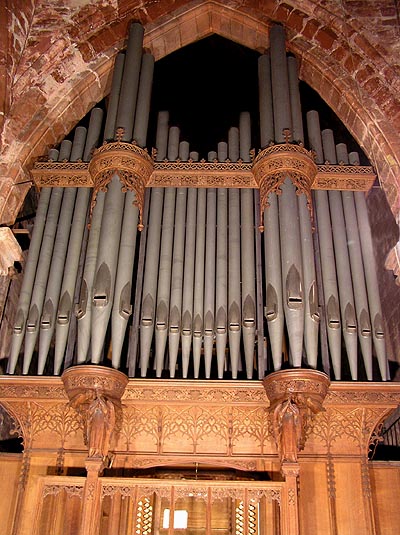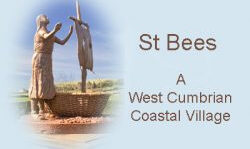The History of the Father Willis Organ
Father Willis Organ History
Why was such an important and magnificent instrument installed in a parish church in West Cumberland? – It is a tale of opportunity and design.
In 1892 a committee was formed to replace the existing organ which stood above the porch at the west door of the Priory. However, progress was slow, and it was not until the arrival of the Rev J. A. Alexander in 1896 that momentum increased. Fund raising started in earnest, and invitations to tender against a specification were issued to the leading organ builders of the day. From the replies the committee whittled prospective builders down to two: T.C. Lewis and Henry Willis. St. Bees could have had a satisfactory though undistinguished instrument, but for two members of the committee who were both knowledgeable and enlightened on the subject of organ building and tonal design.
Francis J. Livesey was organist and choirmaster at the priory from 1887 to his death in 1934. An accomplished player and keen student of tonal design, he had previously been assistant to G.R. Sinclair (the “GRS” of Elgar’s Enigma Variations) who was organist at Hereford cathedral. Livesey was a great admirer of the organs of Henry Willis, and had been strongly influenced by the playing of W.T. Best, whose famous recitals on the magnificent “Willis” in St. George’s Hall, Liverpool, were a major feature of the musical life of the day.
George Dixon was born in St. Bees in 1870, and at an early age he became interested in organ playing. When Livesey came to St. Bees, Dixon became a close friend and was fired with Livesey’s enthusiasm for the work of Willis. Dixon assisted Livesey in the design of the St. Bees instrument, and later, in 1904, he designed the large organ in St. Nicholas church, Whitehaven (now destroyed). In 1909 he produced the much acclaimed design for the instrument in St. James’, Whitehaven, and subsequently advised on many large organ projects. These included the organ rebuilds at Carlisle and Norwich cathedrals, at Trinity, St. John’s and King’s colleges, Cambridge, and the Royal Albert Hall, and he came to be acknowledged as one of the leading authorities on British organ design in the first half of this century.
Livesey and Dixon both considered the work of Willis superior to Lewis’; especially in the reeds, where Willis used a higher wind pressure. They were so determined to have a “Willis” that they offered to pay personally for the addition of a third manual if the contract was given to Willis and the detailed tonal specification was entrusted to Livesey. The committee agreed to this, and Willis travelled up from London to view the priory and discuss details of construction.
The project evidently caught his fancy, and although approaching his 80th year, Willis decided to supervise personally the construction and final tuning. This was probably due to his delight at being given the vast space of the south transept to build in, and his satisfaction with the ingenuity and good taste of the tonal specification. Certainly he seems to have made this organ his “swan song”. He included the stopped diapason that he had originally built for his first cathedral organ – Gloucester in 1847- and also the 16ft pedal open bass formerly in the Lincoln cathedral organ of 1826 by W. Allen.
The organ was opened with a recital on Tuesday May 16th 1899, given by Dr T.H. Collinson of St. Mary’s Cathedral, Edinburgh, at which Willis himself was present. Willis stayed on until the following Saturday to hear Livesey give a recital, and departed satisfied with both his instrument and the playing of its custodian. Willis died in February 1901, but the St. Bees organ remains as a fitting memorial to a half century of brilliant work.

The Organ’s National Importance
Here are extracts from is Cecil Clutton’s tonal assessment of the organ, written in 1946.
The St. Bees specification exhibits certain features unusual at the period, which have since become almost commonplace. Most striking is the insistence upon completing the essential flue and reed choruses, even at the expense of pretty tonal tit-bits, and in this respect only too many modern organ architects have very much to learn from the example of St. Bees
But it is the rigid economy of the design for which the specification is most conspicuous, and it is that feature of making the utmost of any given number of speaking stops which has so outstandingly characterised all Col. Dixon’s work as an organ architect. Within thirty-five speaking stops have been compressed all the important effects to be looked for (but not always found) in a cathedral organ
The organ is fortunate in having the whole of a large and lofty transept for its accommodation, and its layout is therefore most spacious. When he first visited the church in 1896, Willis himself remarked that he had seldom seen a more magnificent site for an organ. In its voicing, he evidently set out to excel himself; perhaps the old man even guessed that it was to be practically his swan song.
The full swell is second in fame only to St. Paul’s, and in effect I doubt if it has ever been surpassed.
The reeds have an indefinable richness of tone which quite disarms criticism. This is particularly true of the basses, and Willis asserted that the contra posaune was the best he had ever made. In the lower register it makes a beautiful pedal solo.
When, to the remarkable economy of the almost perfect specification, is added the miraculous proportioning of the stops one to another, and the splendid voicing, it is not difficult to divine the secret of the instrument’s amazing flexibility. On the surface, there is no reason to lead the player to expect such adaptability; but in the fact the organ is at home alike with Sweelink or Karg-Elert.
The St. Bees organ is, indeed, an apt monument to the men who designed it and the master who built it. One must hope that its original shape will never be materially altered, for it is an instrument of outstanding importance in the history of English organ building.”
